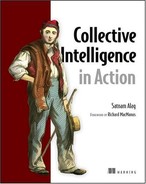List of Tables
Chapter 1. Understanding collective intelligence
Table 1.1. Some of the ways to harness collective intelligence in your application
Chapter 2. Learning from user interactions
Table 2.1. Summary of services that a typical application-embedding intelligence contains
Table 2.2. Examples of user-profile attributes
Table 2.3. The many ways users provide valuable information through their interactions
Table 2.4. Dataset with small number of attributes
Table 2.5. Dataset with large number of attributes
Table 2.6. Sparsely populated dataset corresponding to term vectors
Table 2.7. Ratings data used in the example
Table 2.8. Dataset to describe photos
Table 2.9. Normalized dataset for the photos using raw ratings
Table 2.10. Item-to-item using raw ratings
Table 2.11. Normalized rating vectors for each user
Table 2.12. User-to-user similarity table
Table 2.13. Normalized matrix for the correlation computation
Table 2.14. Correlation matrix for the items
Table 2.15. Normalized rating vectors for each user
Table 2.16. Correlation matrix for the users
Table 2.17. Normalized matrix for the adjusted cosine-based computation
Table 2.18. Similarity between items using correlation similarity
Table 2.19. Normalized rating vectors for each user
Table 2.20. Normalizing the vectors to unit lengthr
Table 2.21. Adjusted cosine similarity matrix for the users
Table 2.22. Bookmarking data for analysis
Table 2.23. Adjusted cosine similarity matrix for the users
Chapter 3. Extracting intelligence from tags
Table 3.1. Raw data used in the example
Table 3.2. Normalized vector for the items
Table 3.3. Similarity matrix between the items
Table 3.5. The normalized metadata vector for the two users
Table 3.6. Similarity matrix between users and items
Table 3.7. Data used for the bookmarking example
Table 3.8. The result for the query to find other tags used by user 1
Table 3.9. Result of other items that share a tag with another item
Chapter 4. Extracting intelligence from content
Table 4.1. The different content types
Table 4.2. Description of the tables used for persistence
Chapter 5. Searching the blogosphere
Table 5.1. Description of the QueryParameters
Table 5.2. The different date formats returned by the different providers
Table 5.3. Query URLs for some blog-tracking providers
Table 5.4. Decomposing the query parameters across providers
Chapter 7. Data mining: process, toolkits, and standards
Table 7.1. Common terms used to describe attributes
Table 7.2. Summary of different kinds of data mining algorithms
Table 7.3. The key packages in WEKA
Chapter 8. Building a text analysis toolkit
Table 8.1. Common terms used to describe attributes
Table 8.2. Available tokenizers from Lucene
Table 8.3. Available filters from Lucene
Table 8.4. Common Analyzer classes that are available in Lucene
Chapter 10. Making predictions
Table 10.1. Raw data used in the example
Table 10.2. Data available when the user isn’t a high-net-worth individual
Table 10.3. Data available when the user is a high-net-worth individual
Table 10.4. Data when user has high-net-worth individual but is not interested in watches
Table 10.5. Data when user has high-net-worth individual and is interested in watches
Table 10.6. Computing the probabilities
Table 10.7. Shortening the attribute descriptions
Table 10.8. The prediction table for our example
Table 10.9. The data used for regression
Table 10.10. The raw and the predicted values using linear regression
Chapter 11. Intelligent search
Table 11.1. Explanation of terms used for computing the relevance of a query to a document
Table 11.2. Description of the query classes
Chapter 12. Building a recommendation engine
Table 12.1. Representing the user as an N-dimensional vector
Table 12.2. Ratings data used in the example
Table 12.3. Correlation matrix for the users
Table 12.4. NearestNeighborSearch classes in WEKA
Table 12.5. Classifiers in WEKA based on nearest-neighbor search
Table 12.6. Term-document matrix
Table 12.7. Sample data for iterative item-to-item algorithm
